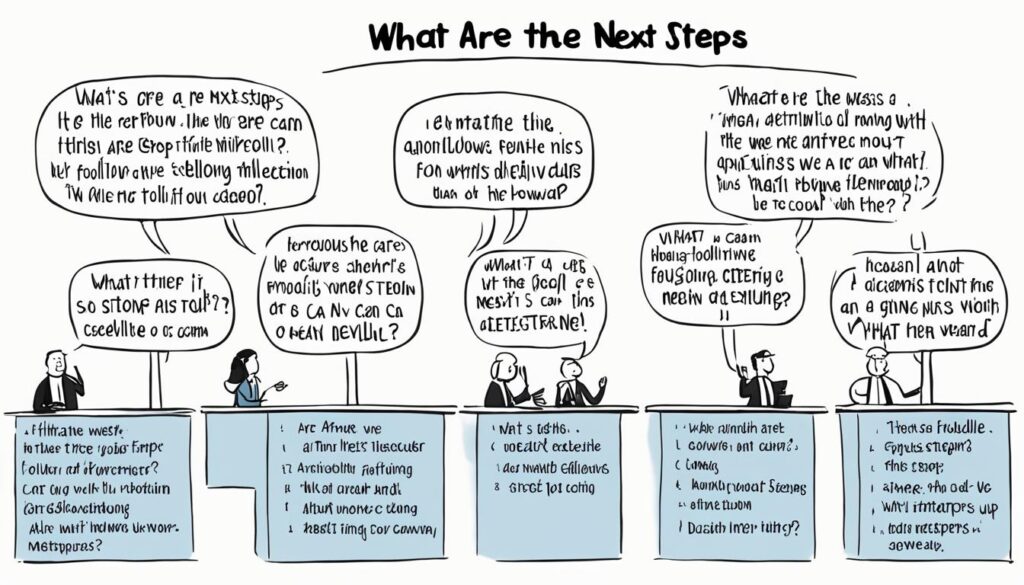As I embark on the journey of effective communication, I find myself lingering on one question: What are the next steps? It is a query that echoes in the air, seeking alternative manifestations, and yearning to transcend the boundaries of routine. In this realm of inquiry, I am compelled to explore new avenues of expression, to wander off the beaten path, and to forge connections with grace and clarity.
There exist myriad ways to articulate the yearning for progress, the thirst for knowledge, and the desire to propel our endeavors forward. When the words “I just wanted to follow up” have spoken their prose too many a time, we must seek refuge in the realm of imagination, where new phrases spark, like stars illuminating the vast expanse of the emailing galaxy.
Key Takeaways:
- Exploring alternative phrases can enhance fluency in emails.
- Being direct and specific in communication fosters clarity.
- Vague phrases can result in unclear responses.
- Politeness and attention to detail leave a positive impression.
- Constructing effective follow-up strategies ensures clear and actionable responses.
I’m Just Following Up Alternatives
When it comes to follow-up emails, it’s important to be creative and avoid using cliché phrases like “I just wanted to follow up.” To help you stand out and capture the attention of your recipient, here are a few alternative phrases you can consider:
- What’s the status of X?
- Has there been any progress on X?
- Where are we with X?
- Do you need any support from me on X?
- I’m checking in on X.
- I’m circling back on X.
By incorporating these alternative phrases into your follow-up emails, you can engage your recipient and keep the conversation flowing. Remember, being creative and specific in your language can make a significant impact on getting the response you’re seeking.
| Phrase | Advantages |
|---|---|
| What’s the status of X? | Clearly asks for an update on a specific matter. |
| Has there been any progress on X? | Indicates a desire to know if any advancements have been made. |
| Where are we with X? | Requests an update on the current state of a particular situation. |
| Do you need any support from me on X? | Offers assistance and shows willingness to contribute. |
| I’m checking in on X. | Conveys a friendly reminder and fosters an open line of communication. |
| I’m circling back on X. | Suggests a previous conversation and seeks to resume discussions. |
By selecting the most appropriate alternative for your follow-up email, you can demonstrate professionalism, engagement, and a clear intent to move the conversation forward.
The Importance of Clear Communication in Emails
In the world of email communication, clear and effective communication is paramount. It is the key to ensuring that your message is understood and that you receive the desired information or action in response. In this section, we will explore the significance of clear communication in emails and provide helpful tips to enhance your email exchanges.
When crafting emails, it is crucial to avoid using vague phrases such as “I just wanted to follow up.” These phrases can often lead to ambiguous responses, causing confusion and delays in the communication process. Instead, strive to be direct and specific in your emails, clearly articulating what you need or are seeking from the recipient.
In addition to being direct, it is important to maintain a polite and professional tone in your emails. Politeness goes a long way in building positive relationships and fostering open communication. So, remember to use please and thank you appropriately in your emails to create a courteous and respectful impression.
Furthermore, taking the time to review your emails for spelling and grammar errors is essential. A well-written email not only demonstrates your attention to detail but also showcases your professionalism and credibility. So, always double-check your emails before hitting that send button.
“Clear communication is the bridge that connects ideas, thoughts, and actions. It lays the foundation for mutual understanding and effective collaboration.”
By prioritizing clear communication in your emails, you can eliminate misunderstandings and ensure that your message is received and comprehended as intended. This will streamline the communication process and increase the likelihood of obtaining the desired outcomes. So, remember to be direct, polite, and meticulous in your email communications to achieve optimal results.
Effective Follow-Up Strategies
When writing follow-up emails, there are a few guidelines to keep in mind:
-
Be direct: Clearly state what you need or are asking for.
-
Be polite: Use please and thank you appropriately in your emails.
-
Check for errors: Proofread your emails to ensure there are no spelling or grammar mistakes.
Using these strategies can help you write effective follow-up emails that receive clear and actionable responses.
Examples of Effective Follow-Up Emails
In this section, I will share some captivating examples of follow-up emails that have proven to be highly effective in achieving desired outcomes. Let’s delve into each email and glean valuable insights from their ingenious approaches.
Twilio’s Personalized Approach
In this email, Twilio exhibits the significance of setting high targets, personalizing the message, and delivering genuine value. By tailoring the content to resonate with the recipient’s specific needs and aspirations, Twilio creates a sense of exclusivity and establishes a strong connection with the reader.
Canva’s Re-engagement Strategy
Canva’s follow-up email utilizes thought-provoking questions to stimulate the reader’s engagement and inspire meaningful interaction. By adopting a conversational tone and showing genuine interest in the recipient’s opinions, Canva humanizes the communication and fosters a stronger relationship with the audience.
Apple’s Humanized Customer Support
Apple’s exemplary email demonstrates the immense power of creating personal connections and displaying genuine care for customers. By empathizing with their concerns and offering swift and tailored solutions, Apple strengthens customer loyalty and showcases their commitment to exceptional support.
Salesforce’s Multiple CTAs
Salesforce’s follow-up email masterfully employs multiple calls to action (CTAs) to cater to diverse leads at varying stages of the customer journey. By providing distinct options based on the recipient’s level of interest, Salesforce guides prospects towards relevant content and encourages proactive engagement.
ReturnPath’s Ice-Cold Lead Follow-Up
In this minimalist yet impactful email, ReturnPath demonstrates the art of asking direct questions to qualify leads and filter out uninterested prospects. By posing a single qualifying question, ReturnPath ensures efficient follow-up efforts and focuses resources on genuinely interested leads.
Examining these examples, we can glean valuable inspiration to craft our own compelling follow-up emails. Each email resonates with recipients by offering personalization, thought-provoking questions, humanized support, strategic CTAs, or direct qualification. Let’s implement these strategies to enhance our own follow-up efforts and maximize desired outcomes.
| Email Example | Key Takeaways |
|---|---|
| Twilio’s Personalized Approach | Aim high, personalize, and offer value |
| Canva’s Re-engagement Strategy | Prime the reader with questions, engage with a human touch |
| Apple’s Humanized Customer Support | Create personal connections and showcase genuine care |
| Salesforce’s Multiple CTAs | Use multiple CTAs for warm leads at different stages |
| ReturnPath’s Ice-Cold Lead Follow-Up | Ask a direct question to qualify and filter leads |
Tips for Asking Effective Sales Qualification Questions
As a sales professional, I understand the importance of asking the right questions to qualify prospects effectively. Mastering the art of asking open-ended questions can significantly impact the success of your sales conversations. Here are some tips to help you ask more effective sales qualification questions:
-
Start with general open-ended questions: When you begin a conversation with prospects, ask open-ended questions that allow them to provide detailed responses. This helps you gain a better understanding of their needs, pain points, and goals. For example, you could ask, “Tell me about your business and what challenges you’re currently facing.”
-
Gauge the prospect’s interest: Pay attention to their tone of voice and body language to assess their level of engagement. This will give you valuable insights into their level of interest and allow you to tailor your questions accordingly. If they seem enthusiastic, dig deeper into specific pain points or goals. On the other hand, if they appear disengaged, try redirecting the conversation or clarifying any potential misunderstandings.
-
Ask about evaluation criteria early on: Understanding how the prospect evaluates new products or services can provide you with valuable information for tailoring your approach. By asking about their evaluation criteria early in the conversation, you can align your sales pitch and highlight the aspects of your offering that are most relevant to their decision-making process.
-
Always ask about the budget: The prospect’s budget plays a crucial role in their decision-making process. By addressing their budget at an appropriate time, you can gauge whether your solution aligns with their financial capabilities. This allows you to focus your efforts on prospects who have the means to invest in your product or service.
-
Close by establishing follow-up steps: Always end your sales conversations by establishing clear next steps. This helps maintain momentum and avoids any confusion or uncertainty. For example, you could say, “Based on our discussion, I’ll send you a proposal by the end of the week. Let’s schedule a follow-up call next Monday to address any questions you may have.”
Remember, effective sales qualification requires asking the right questions and actively listening to your prospects. By implementing these tips, you’ll be well-equipped to have meaningful and productive sales conversations.
| Tip | Description |
|---|---|
| Start with general open-ended questions | Allow prospects to provide detailed responses, gaining insights into their needs and goals |
| Gauge the prospect’s interest | Assess their level of engagement through tone of voice and body language to tailor your questions |
| Ask about evaluation criteria early on | Gain understanding of how prospects evaluate products or services for targeted approach |
| Always ask about the budget | Address the prospect’s budget to focus efforts on those with financial capabilities |
| Close by establishing follow-up steps | End conversations with clear next steps to maintain momentum and avoid confusion |
Open-Ended Questions for Sales Qualification
To truly understand the needs of your prospects and effectively qualify them, asking the right questions is key. Dive deeper into their business, goals, pain points, and more with these open-ended queries:
- May I ask you some questions about your business?
- Could you tell me about your business?
- Why did you choose your niche?
- What are your goals for the next [3, 6, or 12] months?
- How does your company evaluate new products or services before buying?
- What are your biggest pain points?
- Where do you see the biggest opportunities for growth?
By engaging your prospects with these open-ended questions, you’ll gain valuable insights that will enable you to provide tailored solutions and establish a solid foundation for a successful sales journey.
Example Open-Ended Questions in Action:
| Open-Ended Questions | Company |
|---|---|
| “Can you share with me how your business operates and what sets it apart from competitors?” | Company A |
| “What challenges are you currently facing in your industry, and how do you see our solution addressing them?” | Company B |
| “Tell me about your long-term vision for your company and how our product aligns with your goals.” | Company C |
| “What specific factors are important to you when evaluating new vendors, and how do we measure up?” | Company D |
Creating a Great Line of Questioning
When conducting a sales conversation, the art of asking the right questions can make all the difference. It is essential to create a logical and effective line of questioning that guides the discussion towards valuable insights. By crafting your questions thoughtfully, you can gather the information you need to understand your prospect’s needs and tailor your solution accordingly.
- Start with general questions and gradually phase in more specific ones. Begin the conversation by asking open-ended questions that allow your prospect to provide detailed responses. By starting with broader inquiries, you can build rapport and encourage them to share valuable insights. As the conversation progresses, transition to more targeted questions that help you delve deeper into their specific challenges and goals.
- Gauge the prospect’s interest and adjust your questions accordingly. Pay close attention to your prospect’s engagement level and adapt your line of questioning accordingly. If they seem particularly interested in a specific topic, explore it further and dig deeper for more valuable information. On the other hand, if you notice disinterest or hesitation, shift gears to a different area of discussion that aligns better with their needs and priorities.
- Ask about the company’s evaluation process and budget at appropriate times. Understanding how your prospect evaluates new products or services is crucial in tailoring your approach. Look for opportunities to inquire about their evaluation criteria, decision-making process, and timeline. Additionally, addressing the topic of budget can help you align your solution with their financial capabilities. However, be mindful of the timing — don’t jump straight into budget discussions without establishing value first.
- Establish follow-up steps before concluding the conversation. It’s essential to conclude your sales conversation with clarity and purpose. Clearly define the next steps, such as scheduling a follow-up call, sharing additional resources, or arranging a product demonstration. By establishing these follow-up actions, you maintain momentum and demonstrate your commitment to their needs.
By following these tips and creating a well-crafted line of questioning, you can navigate sales conversations more effectively, uncover valuable insights, and forge stronger connections with your prospects.
Examples of Sales Questions in Practice
When it comes to sales, asking the right questions is essential to gain insights into your prospect’s needs and position your solution effectively. Let’s explore some examples of how effective sales questions can be utilized in different scenarios:
1. Establishing the Prospect’s Business
Begin the conversation by asking general questions about the prospect’s business and their niche. This helps gather basic information and sets the foundation for understanding their specific needs and challenges.
2. Evaluating Goals and Challenges
An effective approach is to inquire about the prospect’s goals for the future and the challenges they currently face. By understanding their aspirations and pain points, you can tailor your solution to address their unique needs and position yourself as a valuable partner.
3. Assessing Evaluation Criteria
When discussing your products or services, it’s crucial to ask about how the prospect evaluates new offerings. Inquiring about their specific evaluation criteria provides you with insights into their decision-making process and allows you to showcase how your solution aligns with their requirements.
4. Addressing Priorities and Pain Points
Dig deeper into the prospect’s priorities and pain points by asking thoughtful questions. By understanding what matters most to them and the challenges they’re facing, you can position your solution as the ideal remedy and emphasize its value in addressing their specific pain points.
5. Closing the Conversation
Before concluding the conversation, it’s essential to ask about next steps and establish clear follow-up actions. By proactively discussing the path forward, you can maintain momentum, foster a sense of progress, and ensure a seamless transition to the next phase of the sales process.
By incorporating these examples of effective sales questions into your conversations, you can gain a deep understanding of your prospects, establish meaningful connections, and position your solution in a way that resonates with their unique needs and aspirations.
The Art of Asking Good Open-Ended Questions
Asking good open-ended questions is an art form that plays a crucial role in effective sales communication. When done right, it can unlock valuable insights and foster meaningful conversations with your prospects. Here are some key aspects to consider when crafting open-ended questions:
- Avoid close-ended questions: Instead of asking questions that can be answered with a simple “yes” or “no,” opt for open-ended questions that encourage more detailed responses. This allows you to delve deeper into your prospect’s thoughts and uncover valuable information.
- Focus on one topic at a time: To keep the conversation focused and ensure clarity, ask straightforward questions that cover one specific aspect. This helps both you and your prospect stay on track and maintain a productive dialogue.
- Build trust and rapport: By following a logical sequence and showing genuine interest in your prospect’s answers, you can create a comfortable environment for open communication. This fosters trust and encourages your prospect to share more openly and honestly.
- Tailor questions to the prospect’s level of understanding: While it’s important to demonstrate your expertise, be mindful of using industry-specific jargon that might confuse your prospect. Adjust your language to match their familiarity, making it easier for them to provide meaningful responses.
Mastering the art of asking good open-ended questions empowers you to engage your prospects on a deeper level, uncover their needs, and build stronger relationships. It sets the stage for effective communication and paves the way for successful sales conversations.
Quote:
“The quality of your questions determines the quality of your discovery.” – Unknown
The Benefits of Effective Sales Qualification
In the world of sales, effective qualification is a powerful tool that offers a range of benefits:
-
Understanding your prospect’s needs: By asking the right questions, you can uncover your prospect’s pain points and goals, allowing you to tailor your solution to their specific needs.
-
Saving time and resources: Qualifying prospects early on helps focus your efforts on those most likely to convert, saving time and resources. Instead of chasing dead-end leads, you can prioritize those with the highest potential.
-
Building rapport and trust: Through effective questioning, you can demonstrate your understanding and genuine interest in your prospect’s unique challenges. This builds rapport and trust, essential elements for successful long-term relationships.
Conclusion
I have shared with you the importance of asking effective questions and using alternative phrases to “I just wanted to follow up” in sales communication. By being direct, clear, and considerate in your interactions, you increase your chances of getting the information and responses you need. Remember to implement the tips and examples provided in this article to confidently navigate the next steps in your sales journey.
Effective communication is essential in building relationships with prospects and customers. By asking the right questions, you can understand their needs, save time and resources, and increase your overall sales success. Whether it’s through email or face-to-face conversations, use the strategies outlined here to present yourself as a professional and trustworthy salesperson.
So, next time you’re tempted to say “I just wanted to follow up,” consider using one of the alternative phrases or questions we’ve discussed. Take control of the conversation, be specific about your needs, and show genuine interest in your prospects’ businesses. With these techniques in your toolbox, you’ll be well-equipped to achieve your sales goals and forge strong connections with your audience.
FAQ
What are some alternatives to the phrase “I’m just following up”?
Instead of using the phrase “I’m just following up,” you can consider using the following alternatives: “What’s the status of X?”, “Has there been any progress on X?”, “Where are we with X?”, “Do you need any support from me on X?”, “I’m checking in on X,” and “I’m circling back on X.”
Why is clear communication important in emails?
Clear communication is important in emails to ensure that your message is understood and that you receive the information or action you need. Using vague phrases like “I’m just following up” can lead to unclear responses. It’s important to be direct and specific in your emails, clearly stating what you’re asking for or seeking. Additionally, being polite and checking for spelling and grammar errors can help create a positive impression in your email communications.
What are some effective follow-up strategies?
When writing follow-up emails, there are a few effective strategies to keep in mind: Be direct by clearly stating what you need or are asking for, be polite by using please and thank you appropriately, and check for errors by proofreading your emails for spelling or grammar mistakes. Using these strategies can help you write effective follow-up emails that receive clear and actionable responses.
Can you provide examples of effective follow-up emails?
Yes, here are some examples of effective follow-up emails and what we can learn from them: 1. Twilio’s personalized approach, 2. Canva’s re-engagement, 3. Apple’s humanized customer support, 4. Salesforce’s multiple CTAs, and 5. ReturnPath’s ice-cold lead follow-up.
What are some tips for asking effective sales qualification questions?
When asking sales qualification questions, consider the following tips: Start with general open-ended questions, gauge the prospect’s interest, ask about evaluation criteria early on, always ask about the budget, and close by establishing follow-up steps.
Can you provide open-ended questions for sales qualification?
Certainly! Here are some open-ended questions for sales qualification: 1. May I ask you some questions about your business? 2. Could you tell me about your business? 3. Why did you choose your niche? 4. What are your goals for the next [3, 6, or 12] months? 5. How does your company evaluate new products or services before buying? 6. What are your biggest pain points? 7. Where do you see the biggest opportunities for growth?
How can I create a great line of questioning during a sales conversation?
To create a great line of questioning during a sales conversation, follow these tips: Start with general questions and gradually phase in more specific ones, gauge the prospect’s interest and adjust your questions accordingly, ask about the company’s evaluation process and budget at appropriate times, and establish follow-up steps before concluding the conversation.
Can you provide examples of sales questions in practice?
Absolutely! Here are some examples of sales questions in practice: 1. Establishing the prospect’s business, 2. Evaluating goals and challenges, 3. Assessing evaluation criteria, 4. Addressing priorities and pain points, and 5. Closing the conversation.
What is the art of asking good open-ended questions in sales communication?
The art of asking good open-ended questions in sales communication involves avoiding close-ended questions, focusing on one topic at a time, building trust and rapport, and tailoring questions to the prospect’s level of understanding.
What are the benefits of effective sales qualification?
The benefits of effective sales qualification include understanding your prospect’s needs, saving time and resources, building rapport and trust, and increasing sales success.
Source Links
- https://languagetool.org/insights/post/word-choice-i-just-wanted-to-follow-up/
- https://www.hubspot.com/sales/sales-follow-up-email
- https://blog.hubspot.com/sales/10-tips-ask-sales-questions-si













